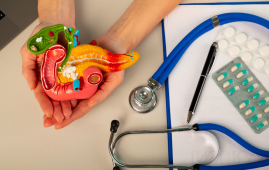

In a groundbreaking collaboration, Professors Jang Hyun Choi and Sung Ho Park from UNIST’s Department of Biological Sciences have unveiled a critical element in the genesis of obesity-induced non-alcoholic fatty liver disease (NAFLD).
Their study highlights Thrap3, a protein linked to thyroid hormone receptors, as a key contributor to the worsening of NAFLD. Thrap3’s role is to suppress adenosine monophosphate-activated protein kinase (AMPK), a pivotal regulator of liver fat metabolism. These findings were published in the journal Experimental & Molecular Medicine.
NAFLD comprises a range of metabolic disorders, including fatty hepatitis and cirrhosis, arising from excessive fat buildup. Despite its widespread occurrence, viable NAFLD treatments have remained limited. However, this pioneering investigation unveils potential therapeutic avenues.
Utilizing rat-based experiments, the research group illustrated Thrap3’s direct binding to liver-based AMPK. This binding hinders AMPK’s migration from the nucleus to the cytoplasm, compromising the critical process of autophagy responsible for triglyceride breakdown and cholesterol reduction. Consequently, targeting Thrap3 expression emerges as a promising strategy for treating NAFLD effectively.
We have encountered significant challenges while developing treatment strategies for non-alcoholic fatty liver disease. However, our discovery of the Thrap3 gene provides us with an effective method to tackle this condition,” commented Professor Choi.
Furthermore, it was verified that the effective inhibition of Thrap3 expression leads to notable improvements in non-alcoholic steatohepatitis (NASH), an inflammatory condition linked to fatty liver.
An abstract from the Nature Journal reports – Autophagy is vital for cellular health and metabolism. Dysregulated autophagy contributes significantly to nonalcoholic fatty liver disease (NAFLD) progression. It aids lipid breakdown and maintains healthy mitochondria. However, the mechanisms behind autophagy disruption in NAFLD were unclear. Our study reveals increased Thrap3 expression in NAFLD, and liver-specific Thrap3 deletion improved lipid metabolism and autophagy in an NAFLD model. Thrap3 deficiency facilitated AMPK translocation and activation via direct interaction. This highlights Thrap3’s role in NAFLD and its potential as a treatment target.
more recommended stories
 36-Week Pre-eclampsia Screening May Reduce Term Risk
36-Week Pre-eclampsia Screening May Reduce Term RiskA New Preventive Strategy for Term.
 Cardiovascular Risk and Sudden Cardiac Death in Diabetes
Cardiovascular Risk and Sudden Cardiac Death in DiabetesRising Sudden Cardiac Death (SCD) Risk.
 Poor Kidney Function and Alzheimer’s Biomarkers Explained
Poor Kidney Function and Alzheimer’s Biomarkers ExplainedPoor kidney function may influence levels.
 Walking Speed Before Hip Replacement Predicts Recovery
Walking Speed Before Hip Replacement Predicts RecoveryNew Evidence Points to a Simple,.
 Neuroblastoma Drug Combo Extends Survival in Models
Neuroblastoma Drug Combo Extends Survival in ModelsA Promising Shift in High-Risk Neuroblastoma.
 How Soybean Oil Impacts Weight Gain and Metabolism
How Soybean Oil Impacts Weight Gain and MetabolismWhy Soybean Oil May Affect Metabolism.
 Coffee and Cognitive Function: Evidence Review
Coffee and Cognitive Function: Evidence ReviewA new narrative review in Cureus.
 Colorectal Cancer Screening Rates Low in Adults 45–49
Colorectal Cancer Screening Rates Low in Adults 45–49Recent UCLA research reveals that colorectal.
 Gut Immune Cells and Long-Lasting Antiviral Protection.
Gut Immune Cells and Long-Lasting Antiviral Protection.Breakthrough Findings on How Gut Immune.
 Mild Pancreatic Duct Dilatation Signals Higher Cancer Risk
Mild Pancreatic Duct Dilatation Signals Higher Cancer RiskEarly Structural Changes Offer Critical Clues.

Leave a Comment